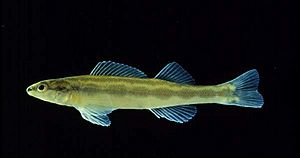Goldline darter facts for kids
Quick facts for kids Goldline darter |
|
|---|---|
 |
|
| Conservation status | |
| Scientific classification |
The goldline darter (Percina aurolineata) is a small, colorful freshwater ray-finned fish. It is a type of darter, part of the Percidae family. This family also includes perches and pikeperches.
This fish lives in the United States. You can find it mostly in the Cahaba River in central Alabama. It also lives in the Coosa River in Georgia and Alabama. The goldline darter is a small fish. It usually grows to be less than 3 inches (7.6 cm) long. It likes areas with moderate to fast water currents. It prefers water deeper than 2 feet (60 cm). These areas are usually in the main parts of free-flowing rivers. The river bottom often has rocks, cobbles, or boulders. There are also aquatic plants growing there.
The goldline darter has been listed as a threatened species since 1992. The International Union for the Conservation of Nature says it is a "vulnerable" species. This means its population is at risk.
Contents
What the Goldline Darter Looks Like
This fish is usually between 1.6 and 2.9 inches (4 to 7.4 cm) long. It has brownish-red and amber stripes along its sides. Its back is a light to dark color.
The goldline darter has a white belly. You can see square-shaped blotches on its sides and back. These blotches are separated by a pale or gold-colored stripe.
Where Goldline Darters Live and Their Habitat
The goldline darter is found only in certain places. It lives in the Cahaba River system in central Alabama. It also lives in the Coosa River system in Georgia and Alabama.
There are two separate groups of goldline darters in the Alabama River Basin. One group lives in the middle Cahaba River system. The other group is in the Coosawattee River system. This river flows into the Coosa River.
This fish likes to live in areas where the water flows at a moderate to fast speed. It prefers water that is deeper than 2 feet (60 cm). These areas are usually in the main channels of rivers that flow freely. The river bottom in these spots is often made of bedrock, cobble, or small boulders. You might also find patches of water willow or other river plants there.
Goldline darters start to lay their eggs in March. They continue to spawn through May or June.
Why the Goldline Darter is at Risk
The goldline darter is threatened because the water quality in the Cahaba River is getting worse. Activities like strip mining can harm the water. Growth of cities (urbanization) and sewage pollution have caused some groups of these fish to disappear.
Building dams and reservoirs has also hurt the goldline darter. These structures can separate and isolate groups of fish. This makes it harder for them to survive and reproduce.
Efforts to help the goldline darter will focus on protecting its habitat. They will also work on improving the water quality. The biggest drop in fish numbers has been in the Little Cahaba River. The International Union for the Conservation of Nature calls this fish "vulnerable." This is because there are not many of them left. Also, their living places are still being harmed.
- Froese, Rainer, and Daniel Pauly, eds. (2011). "Percina aurolineata" in FishBase. September 2011 version.
See also
 In Spanish: Percina aurolineata para niños
In Spanish: Percina aurolineata para niños


